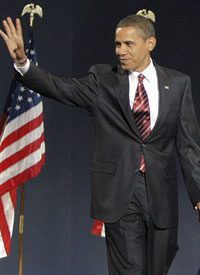
President Obama ran a shrewd and successful campaign in 2008. Based on his travel itinerary, it appears that he might have started his 2012 reelection bid a little early. The New York Times reports:
A trend is emerging in President Obama’s out-of-the-gate travel itinerary: Top billing has been given to states that turned from red to blue last fall…. Given these early destinations, is the president already eyeing re-election?
States, counties, and numerous municipalities are all lining up at the federal trough to get some of Obama’s stimulus. USA Today ran a story about how the money will be spent. “In Virginia, Democratic Gov. Tim Kaine is taking a grass-roots approach, setting up a website seeking input from residents, local governments and community groups. Nearly 600 suggestions poured in on the first day.” The federal funds aren’t only going to help pay for state services but also various public works projects.
Is the goal of this to “stimulate” the economy or is to “stimulate” votes? Economist Dr. Robert Higgs recounts how President Richard Nixon used government intervention into the economy to help his reelection chances.
Like most incumbent politicians, Nixon gladly took advantage of crises to augment his power, but he did not simply sit waiting for an emergency to come along. For him, the risk that he might not be reelected was crisis enough. According to his economic adviser Herbert Stein, he “tended to worry exceedingly about his reelection prospects and so to feel impelled to extreme measures to assure his reelection.” Years before the election of 1972, Nixon and his aides began to scheme how they could maximize the likelihood of his reelection by manipulating the economy and creating as much apparent prosperity as possible before election day.
The Republican president famously stated that “we’re all Keynesians now” — referring to socialist economist John Maynard Keynes — and severed the link between the dollar and any gold standard as well as instituted disastrous price controls which led to shortages, particularly of gasoline. Of course, these shortages happened after Nixon had won a second term. Economist Thomas DiLorenzo also explains how Nixon’s Federal Reserve Chairman, Arthur Burns, helped engineer Nixon’s reelection.
Even though [Burn’s] staff informed him in the fall of 1972 that the money supply was forecast to grow by an extremely robust 10.5 percent in the third quarter, Burns advocated ever faster growth before the election. The growth rate in the money supply in 1972 was the fastest for any one year since the end of World War II and helped re-elect Richard Nixon.
Could President Obama be playing a similar game with his stimulus funds? Buying future votes by aggressively intervening into the economy without regard for post reelection consequences? Steve Sailer of Vdare.com has argued that indeed there are political implications to Obama’s public works programs.
A major goal of the Obama Administration will be to keep millions of illegal immigrants from going home, which would deprive the Democratic Party of large numbers of votes in coming decades from them (after they are put on “the path to citizenship”) and, more importantly, their American-born (and thus birthright citizen) children. Spending hundreds of billions of the taxpayers’ dollars to keep illegal immigrant construction workers previously employed putting up unneeded McMansions in exurban Las Vegas from leaving the U.S. is a small price to pay for future Democratic dominance.
Sailer points out the political viability in keeping a reliable Democratic constituency in the country but the stimulus runs the gamut of special interests. There are a lot of votes to be bought out there, but it would appear that they are being bought by a currency which is rapidly devaluing. The truly frightening part is that a lot of these funds are being printed to pay bills for political gain. Frank Shostak, chief economist of M.F. Global, is extremely concerned about the future of the dollar.
It is apparent that we’ve learned nothing from several millennia of monetary destruction. The persistent demonstration that capital, not paper, is the basis for prosperity has fallen on deaf ears. Daily, we face the sad spectacle of government officials, pundits, and even Nobel laureates telling us that printing money is the answer to an economic downturn.
Considering the precarious financial position of the United States, it would be quite dangerous to play purely political games with the economy, but that might be exactly what the president plans. Economic commentator Peter Schiff doesn’t feel that Obama’s attempt to create an illusion of prosperity will work and he warns that these interventions will soon be disastrous for America.
After more than a decade of unsustainable borrowing and spending, the private sector is currently attempting to restore balance through reduced consumer and mortgage credit, greater savings, and lower asset prices. With its trillions of dollars of credit injections and stimulus programs, the government hopes to allay this process by force-feeding Americans a diet of more borrowing. They feel that a restored securitization market will help. It won’t. It will just grease the skids for a quicker collapse.
Photos: AP Images



